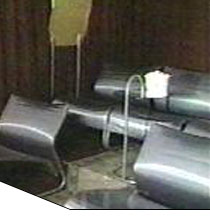



![]()

Paint, Patience and Countless Hours
By Bess Liebenson There were still several weeks to go, but it was a madhouse, a sort of frenzied euphoria, behind the scenes at the Tomes-Higgins Designer Show House at Christ Church in Greenwich. Scaffolds and paint buckets were everywhere; carpenters, painters, muralists and interior designers were trying not to trip over each other in their down-to-the-wire dance — before everything would fall into place. From idea to presentation, what does it take to put a show house together? "We had a splendid product to begin with," said FiFi Sheridan-Barbian, chairwoman of the show house. The circa-1861 house, designed by Calvert Vaux "had already been rehabbed by the church at a cost of two years and $2.3 million," she said. But a show house cannot happen without a plan. "We had 18 months to build and establish a small corporation with different components" — advertising, public relations, advance sales, historians, boutique, cafe, preview party and house operations, staffed by an executive committee of 15 with some 60 people working under them, many full-time and all volunteers. To be successful the show house had to be a profit-making center. "We expect to make a profit on everything related to the show house," Ms. Barbian said. "We publish a show house magazine with a print run of 12,500, distributed to show house visitors with admission of $20 at the door, $18 in advance. We've gone out and sold ads, written articles and interviewed dignitaries whose letters are included." There is a boutique and a cafe, with their take on the cafe hoped to be 10 to 20 percent of the gross. Boutique items are mostly consigned from some 40 vendors, the show house profit 20 percent. And while each designer is responsible for decorating a room — with artifacts, antiques, upholstery, lamps, decorative items and china — almost everything is for sale, with 20 percent contributed to the show house. Then, too, there is the preview party, priced from $100 to $500 a head with 350 to 400 expected to attend. But the foundation of a show house is identifying designers. A committee researched and developed a broad list of designers (200 names), who were invited to an open house to see it in its raw state. The designers were asked to fill out forms with first, second and third choices, to submit descriptions of how they would interpret a room (kitchen and baths are predetermined) and how they would use fabric and furniture. The committee spent six hours a day for a full week selecting 24 designers. "We could have done three or four houses," said Ms. Barbian. "There are no fees to the designers. Their commitment is the time, staff and money to make a room spectacular. For them it's a marketing opportunity. Our responsibility to the designer is to make sure we get as much publicity and sell as many tickets as possible to make it viable for them. "It would be a disaster if we were doing a house of this magnitude, and only 1,000 people showed up. The last show house in Greenwich, in 1991" — show houses have become increasingly rare compared to house tours — "attracted 13,000, and we are hoping for at least that many, and more." The 24 designers chosen are of high caliber, some voted by their peers as among the top 10 in their fields, their work featured in Architectural Digest, House & Garden, Veranda and other design publications. They have decorated homes for Robert Redford, Barbra Streisand, any number of Park Avenue apartments and worked all over the world. "Our appeal is the historical house itself and that it is in Greenwich," said Patricia Baity, senior warden of Christ Church, referring to Dumpsters, instead of fancy cars, in driveways. "That translates into a lot of people interested in redecorating." Each room, with its different needs, can be a logistical and scheduling nightmare. Construction work has to be scheduled, completed and cleaned up before painters come in and designers begin to do their magic. And before the furniture arrives, lighting fixtures have to be installed. One electrician, on call for three weeks, adapts to the schedules and personalities of 24 designers. As opening day neared, it was bedlam. Even during Hurricane Floyd, deliveries were made, and they continued, a constant stream until D-Day. In the end, unless otherwise agreed, designers have to return rooms to their original state. Hundreds of yards of fabric have begun to be layers of curtains and drapery, and hundreds more will cover upholstery. A kitchen-living room on the first floor, destined to serve as the cafe, is being painted in chinoiserie style. Suzanne Bellehumeur of Old Greenwich — using a polished Venetian plaster technique featuring birds, lanterns and bamboo trees — guessed that it would take 80 hours to do the 55-square-foot wall space, including painting cornices and a table. "Careful you don't trip," someone yelled as floor cloths — yards and yards of paper, plastic and cloth taped over the rugs (of the 8,000-square-foot house) — got frayed and then entangled the feet of delivery people and others. Scott Salvator, who said he has done about 20 show houses, described the process from the interior designer's perspective. "It's a selection process, not a lottery," he said, "an all-inclusive evaluation in terms of getting in and what room you get, based on work, talent and reputation. It costs $20,000 to $30,000 to do this living room, not including time, about nine months." Everything was custom made, some pieces made in California and air freighted. "Fabric houses," he said, "sponsor certain designers. They want to know for whom and what the work will be. My work is established and would reflect not only my but their style. Antiques dealers don't want to lend items until the last minute." As a chaise longue, love seat and two chairs were delivered, Mr. Salvator said, "It's just starting. The hell week of show houses is the week before. Designers are like their personalities. Some install in military fashion, some are last-minute charleys." Wendy Leary, an interior designer and Douglas Wilson, a decorative artist, who were collaborating on an entry hallway, were impossible to miss. Having used six gallons of periwinkle blue tinted plaster and a coat of wax to which they added 10-inch stripes in a lighter shade, their finishing stage involved polishing walls with 30 pads of steel wool. The walls took three people four weeks. The 40-yard jute Berber carpet was donated. The white-washed Swedish furniture — two chairs, a console table, a bench, a book shelf and some trunks — were bought at a flea market. "I fell in love with the pieces and had to have them," Ms. Leary said, adding, "the overall cost, including electrifying five wrought-iron candle lanterns, was roughly $6,000." In the same entry space, a designer, with a lamp in one hand and a plant stand in the other, had to maneuver past two deliverymen carrying a large sheet of plexiglass. This is the way it has been for the designer and artist, working on scaffolds, having to stop and start. And so it went. One visitor shouted to another, "Wait'll you see the wild bathroom!" The bathroom, a flight up, turned out to be inhabited by a Rousseau-like lion peeking from between a pair of leopard-print shower curtains. On the floor was a leopard print-bordered floral rug; three lively animal murals completed the scene. "I didn't have to purchase anything," said Elizabeth Read Weber of Greenwich, a 36-year-old interior designer. "Everything was donated or loaned. If I had to reproduce it, the cost would be about $30,000." Outside the house, a carpenter, Lyman LaFreniere of Stamford, was painting a kiosk he had built and installed as a donation to the show house project. Its design mimicked the house whose lawns are lined with curving stone paths; facing the house was a 325 square foot playhouse-model of Mount Vernon in its finishing stages. The Tomes-Higgins Designer Show House at Christ Church, 216 East Putnam Avenue in Greenwich, is open through Oct. 24. The number to call for ticket information and hours is (203) 552-1097. |
